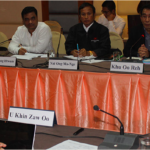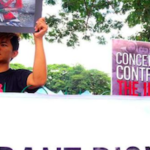By Pangmu Shayi / Kachinland News (KLN) | December 17, 2016
A newly formed coalition of ethnic armed organizations (EAOs) calling itself the Northern Alliance-Burma (NA-B), began launching coordinated strikes against Burma Army positions in Northern Shan State on November 20. The NA-B is made up of the Kachin Independence Army (KIA), the Ta’ang National Liberation Army (TNLA), the Myanmar National Democratic Alliance Army (MNDAA), and the Arakan Army (AA). The clashes centered around the bustling border trade town of Muse, and the small Kachin Sub-state town of Mong Koe, which abuts the China border and the Kokang MNDAA area. The offensives resulted in the closure of the Mile 105 trade zone and occupation of Mong Koe by Alliance troops for a short period of time.
The economic impact of the disruption of the lucrative border trade and the human toll in deaths and injured on both sides is not immediately known. While in-depth coverage of the clashes in independent Burmese news outlets has been scant, well documented reports from the ground tell of the toll on innocent civilians. Thousands of civilians have been displaced, most seeking shelter on the Chinese side. The reports also detail the abduction of about 100 wedding guests (locals and Chinese citizens), and kept as hostages or human shields at Byuha Hill, a strategic army base, the rampant destruction wrought on civilian homes and properties by army air strikes, and the torching of homes and granary barns after the army regained control of Mong Koe. However, the most serious casualty arguably is the Second or 21st Century Panglong, as irreparable damage may have been inflicted on the so-called nationwide peace process.
The attacks signaled a shift in tactics for the coalition. They had never before made forays into government controlled urban areas, confining themselves to defensive warfare instead. The NA-B characterized the assaults as controlled or limited warfare, concentrating on preemptive strikes designed to thwart the Burma Army’s continued deployment in ethnic territories.
The army responded with massive troop increases, and the deployment of heavy artillery, fighter jets and helicopters. Army Chief Min Aung Hlaing publicly raised the specter of an army takeover, alluding to the 2008 army drafted constitution which makes provisions for such a move in a state of emergency. There was also an army spearheaded attempt to label members of the NA-B “terrorist organizations” – thwarted in the Lower House, but passed in the Shan State parliament where military allied Union Solidarity and Development Party (USDP) and army representatives hold a majority of seats.
The vote was not binding as it had failed to pass at the national level, but has been strongly condemned as being detrimental to the peace process by the 8 EAOs who signed the Nationwide Ceasefire Agreement (NCA), and the United Nationalities Federal Council (UNFC). A prominent Karen voice has also weighed in on who better fits the “terrorist” label:
Who is it that rampages through the countryside, looting, torturing, killing and raping innocent civilians? Who is it that people are so terrified of that they run away at first sight of their advance? The people know full well the answer to these questions!
It is not that we ethnic peoples are against peace and coexistence with the Bamar brethren. Did not our forefathers, putting their trust in the Bamar promise of “full autonomy in internal administration”, signed the Panglong Agreement in 1947 which gave birth to the Union that we know of today? The fact of the matter is that in the intervening years, the ethnic peoples have become so disenchanted with the Bamar dominated central government for its broken promises and exploitation of land and resources that they had chosen the path of armed insurrection to regain their inherent rights. This in turn has brought on the brutal occupation of ethnic lands by the Burma Army.
There have been intermittent attempts at negotiating peace, but thus far, none have borne lasting fruit. There was a 17-year period of ceasefire in the Kachin area, but it fell apart when the military government, with the view of neutralizing the KIA, forced it to convert to a border guard force. This led to the renewal of war in the Kachin area in 2011.
Even so, the KIO (the political wing of the KIA), steadfastly participated in the peace process initiated by the Thein Sein government. This in spite of its positions being shelled even as peace talks were being held. What transpired was that the KIO refused to sign on to the much touted Nationwide Ceasefire Accord (NCA), since it was not truly ‘nationwide’, given the exclusion of 3 of its allies, the MNDAA, TNLA and AA. The NCA ended up being signed by only 8 of the 16 participating EAOs. In the meantime, the KIA frontline post of Gidon has been bombarded incessantly for more than 3 months now, just as attacks on MNDAA and TNLA positions have been on-going.
With the advent of the civilian government led by Daw Aung San Suu Kyi, an attempt to breathe new life into the peace process was made through the convening of the 21st Century (or Second) Panglong Conference. But expectations of a breakthough fell flat when it also failed to be all inclusive. Interestingly, in the lead up to the conference, Daw Aung San Suu Kyi’s tone-deaf remark that EAO leaders should not just think of making demands but consider what they can bring to the table instead, resulted in this impassioned retort from U Khoo Oo Reh of the Karenni National Progressive Party (KNPP):
Come and take a look at our ethnic lands. Our rivers have run dry. Our mountains have been levelled. Our forests are no more. Our plains have turned into deserts. All our natural resources are gone. Our people have had to flee homes and villages to live out their lives in IDP camps. What more do you expect us to give? We have nothing left to give!
The renewed Kachin war is now well into its 6th year. The fighting shows no signs of letting up. Rather, it is growing in intensity and spreading even to urban areas. The IDP situation is becoming increasingly more desperate, with all international aid to border camps cut off, while the number of IDPs keeps growing. Moreover, with the much hoped for breakthrough in the peace process with the installation of a new civilian government now seem doomed, so do prospects of their longed for return to former homes and farms.
Weighed down by the abuse and persecution they have had to endure for so many years, from generation to generation, the Kachins are now at breaking point. Just as cries of Uhuru, Swahili for freedom, reverberated throughout Kenya at the height of the resistance movement against British colonial rule, clamors for Awm Dawm, its Kachin equivalent, are now echoing through Kachinland.
It might surprise non-Kachins to learn that the KIO is the voice of restraint where awm dawm is concerned. Mindful of the terrible sacrifices such a radical venture would entail, it had concentrated on working in tandem with other UNFC members to call for federalism within the Union. But KIO leaders are under intense pressure from their people and the demand for awm dawm.
A KIO leader’s recent allusion to secession sparked the Bamar remark that it “impinged upon the red line” – a line that must not be crossed. To the ethnics, the “red line” reference smacks of hegemonism and bully tactics. Just as no ‘red line’ should exist to keep a woman from leaving an abusive relationship, no threats should be levelled at the Kachin, or any other ethnic group for that matter, wishing to exercise their right to secession. For after all, the Panglong Agreement, much like a marriage contract, is a pact whereby ethnic peoples pledged their troth with the Bamars, with the “pre-nup” clause of the right to secession written in by far-sighted leaders, in case the union did not work out.
It goes without saying that a breakup of the Union would be disastrous and traumatic for all concerned. Indeed it would be the height of irony if the Union that the father worked so hard to bring about, were to disintegrate at the hands of the daughter. The onus then is on the Bamars – specifically the daughter of the architect of the Union, in her capacity as head of the current civilian government, and the army that he created – to make the ethnics want to stay. There is real danger of a breakup unless sincere efforts to facilitate an all-inclusive peace process are made, and guarantees given for an equitable sharing of power within a federated system. Anything less would fail to bring about the genuine peace and reconciliation the country so desperately needs.
This article originally appeared on Kachinland News (KLN) on December 17, 2016.







